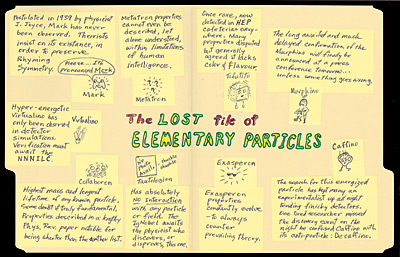RESULTS! The particles of our readers’ imaginations
We asked you to use Roz Chast’s cover of the May issue of symmetry as inspiration to go beyond the elementary particles already discovered or theorized and tell us about the particles of your dreams. The dozens of responses were clever, funny, and insightful.
It was difficult to choose a few entries to highlight. Those that stood out most made us laugh or think, and sometimes both.
1st place
The Lost File of Elementary Particles
Chuck Yoneda from Stanford Linear Accelerator Center entered The Lost File of Elementary Particles, which mixed scientific principles with humor, winning him first place and an autographed copy of Roz Chast’s cover for the May 2007 issue of symmetry. Runners-up received posters of the Chast cover.
Chuck Yoneda, SLAC
 |
2nd place
Leapton
A particle created anytime someone jumps on the bandwagon in support of an elegant but unprovable theory.
Julie Phillips (text) and Greg Kuebler (illustration), JILA, Boulder, Colorado

3rd place
Blogino
Particles created by non-abelian Blog-Blog interactions. Bloginos typically are produced in a very excited state and with a high degree of spin. Even though all their properties have not yet been determined, it is commonly agreed that they exhibit considerable truthiness. They also have the annoying ability to propagate into extra dimensions, away from the blogosphere, and generate lots of phone calls.
Jacobo Konigsberg, Fermilab

Runners up

Rockon
Responsible for such things as face-melting guitar solos, heart-pumping rhythms, screaming vocals, and hair bands. Observation of the rockon over the airwaves has been on the decline since 1995.
Ike Hall, Fermilab
Oreo
When near a small child, the Oreo undergoes spontaneous fission, revealing a creamy center. Note: The center always ends up on one side, illustrating the principle of symmetry violation.
John T. Collier, Winfield, Illinois
Velcron
Holds together all the seemingly huge particles formed in high-energy collisions at the Tevatron. Since the lifetimes of these particles are so short, it must be the velcron that holds the pieces together until they run into a stronger force, at which time they detach. Comes in two species, the loop velcron and the hook velcron.
Paul C. Czarapata, Fermilab
Postiton
Carrier of the ultraweak force, the postiton was invented for those jobs for which the gluon is just too sticky. It comes in stacks, just like D-branes in string theory.
Lance Dixon, SLAC
Click here to download the pdf version of this article.


